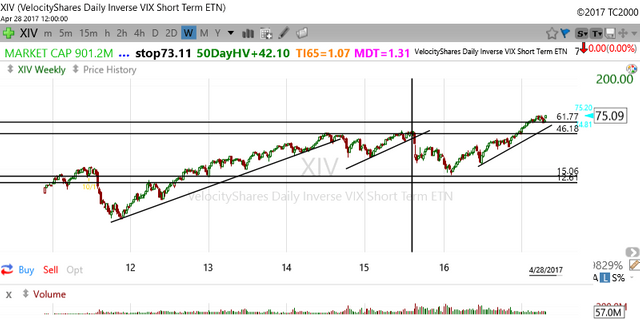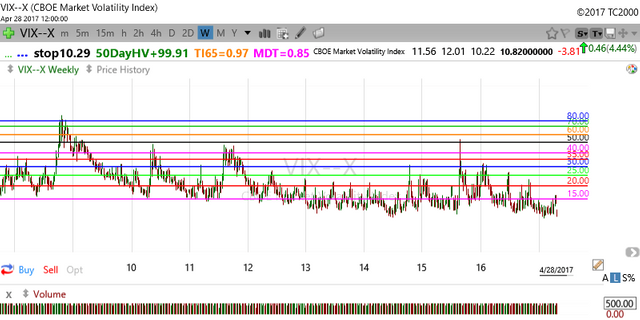XIV Trading Method Detailed
XIV Defined
Definitions
Another method that I trade revolves around the ETF XIV. What is XIV? Here is the Fund Summary from Yahoo Finance:
The investment seeks to replicate, net of expenses, the inverse of the daily performance of the S&P 500 VIX Short-Term Futures index. The index was designed to provide investors with exposure to one or more maturities of futures contracts on the VIX, which reflects implied volatility of the S&P 500 Index at various points along the volatility forward curve. The calculation of the VIX is based on prices of put and call options on the S&P 500 Index. The ETNs are linked to the daily inverse return of the index and do not represent an investment in the inverse of the VIX.
Essentially XIV is the inverse of the VIX. What is the VIX? Here is the Investopedia definition:
VIX is the ticker symbol for the Chicago Board Options Exchange (CBOE) Volatility Index, which shows the market’s expectation of 30-day volatility. It is constructed using the implied volatilities of a wide range of S&P 500 index options. This volatility is meant to be forward looking, is calculated from both calls and puts, and is a widely used measure of market risk, often referred to as the “investor fear gauge.”
Complexities abound
The VIX is a very complicated instrument. I have read a good chunk of the book(affiliate link) Options as a Strategic Investment
It takes two to Contango
The main reason we are interested in trading XIV is that the VIX itself has a long term negative bias due to a phenomenon known as Contango. The VIX spends a large percentage of its time in Contango. Long story short Contango equals a negative bias for the VIX which equals a positive bias for XIV. You can see this very clearly on the XIV chart:

Risks; Why must you always spoil the party?
This upward bias means having a very high winning percentage is very possible. But what are the risks? There are some major risks to consider. First, the VIX is by it’s very nature, extremely volatile. This can cause massive moves down in the XIV. An event similar t0 2008 would be major trouble for XIV. This means it is important to not get carried away with position size on XIV.
Another, related, risk is due to XIV being an ETN. An ETN, or exchange traded note, is a debt instrument. Long story short a black swan event that causes a massive daily spike in the VIX could cause XIV to close down(By the way, the blog I linked to here sixfigureinvesting.com is outstanding for learning more about VIX trading). It is unlikely, but a possibility. The final risk is the opposite of Contango, Backwardation. The VIX can occasionally enter long periods of Backwardation, causing a downward bias in XIV.
A lot of people put a small amount of their account into XIV and invest in it. Every dip they buy a small chunk. This is a valid strategy and one I employ as well. How can we trade it though?
The Strat
Buys
Let’s get to how I trade XIV. A very healthy chunk of my returns have come from this strategy. That doesn’t mean it is perfect, it far from it and like all of my strategies I periodically make incremental tweaks. I trade XIV similar to how I trade Bitcoin. I place incremental buy orders that increase in size as XIV decreases in price. At roughly a 50% pullback in XIV will be my last and biggest order. I will adjust these upward as needed based on XIV’s price movements.
Position Size
I make sure that the absolute max of my trading account that will be in XIV is 25% of my account. Now given the risks outlined earlier, this is a high percentage. I am a risk taker, not a natural one, it has been something I had to slowly work towards as I have gotten more comfortable with my trading. Keep in mind the only way I will get to 25% of my account in XIV is with a 50% pullback in XIV. Those do happen, but are not an every day occurrence. I would advise if you are a fairly new trader to not use that high of a percentage for position size.
Sells
Now for sell orders, I do tiered orders as well. At a 10% gain I will sell a small chunk, bigger chunks at 20%, 30%, and 40%, at 50% roughly half, and at or before 100% I want to be completely out of the trade. I will keep a very small amount of each trade as the “investment” portion of this. I set my sell percent based on my average cost basis for XIV.
Stops
I do not utilize stops on this strategy. That is why it is imperative to limit your position size. Again, 25% is a bit high when not using stops. You have to be comfortable with fairly deep drawdowns to trade this way. Unfortunately, occasional deep drawdowns can equal long term great returns if you are patient. It is a trade off that you have to be comfortable with. Once I get my account to a certain size I will probably alter this, lowering my position size and including stops. I am getting close to that point in fact. If you have a smaller account and you are using risk capital, that is capital that you can risk and it will not cause financial ruin, than this can be OK. I would not recommend it with larger accounts though.
Final Thoughts
The strategy itself is fairly straight forward, but I do recommend taking the time to at least have a rudimentary understanding of how VIX and XIV work. Also, there are a million ways one could alter this strategy. It is certainly possible to improve upon this formula. One thing I do look at is the VIX chart itself. In fact, in most Inverse and Leveraged ETFs I would recommend actually making trading decisions based on the chart of the instrument itself and not the inverse or leveraged chart. Due to the complexities of VIX and XIV I have found putting more weight on the XIV chart has worked for me. But, as I said, I do like to include the VIX chart in my decisions. Here is the VIX chart in Telechart(I set it on weekly to get more data, but I usually like to look at the daily):

You can see I put horizontal lines at 15, 20, 25 and so on. This just gives me a visual for where the VIX is at. You can also see the downward bias in the VIX caused by Contango. One could set alerts, or even conditional orders to buy XIV when the VIX reaches certain levels. I personally just use it as a general guide. For example buying XIV with the VIX at new all time lows as it currently is, is probably not sound.
Need help? Ask.
Please feel free to take this strategy, alter it and make it your own. As I stated earlier, start small with this and work you way up to bigger position sizes as you get more comfortable with it. Any questions, as always, please ask.
_Disclaimer
The advice provided on this website is general advice only. It has been prepared without taking into account your objectives, financial situation or needs. Before acting on this advice you should consider the appropriateness of the advice, having regard to your own objectives, financial situation and needs. Where quoted, past performance is not indicative of future performance.
SpeculateFreedom.com disclaim all and any guarantees, undertakings and warranties, expressed or implied, and shall not be liable for any loss or damage whatsoever (including human or computer error, negligent or otherwise, or incidental or consequential loss or damage) arising out of or in connection with any use or reliance on the information or advice on this site. The user must accept sole responsibility associated with the use of the material on this site, irrespective of the purpose for which such use or results are applied. The information on this website is no substitute for financial advice._